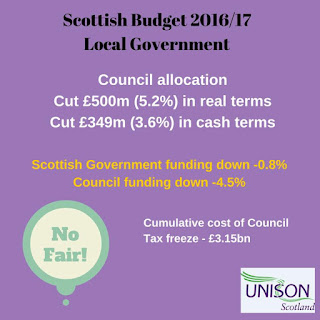In recent days there have been many political exchanges over job losses as a consequence of the cuts to council grant allocations in the Scottish Budget for 2016/17. Let’s look at the issue calmly.
John Swinney’s view is that job losses have been “utterly exaggerated”. Christina McKelvie MSP says, “But there are not 1,000’s losing jobs, that’s just made up”.
The most widely quoted estimate for job losses is 15,000. This figure doesn’t come from the trade unions; it comes from COSLA. They do after all after access to most of the councils and their senior officials that actually have to deliver the cuts. I am not a party to their calculations, but it is clear that they are based on the consequences of both the grant allocation cut and the additional unavoidable commitments councils have to finance next year.
What we do know for certain is the combined General Resource Grant + Non-Domestic Rates Income figure, which is used to calculate local government’s total revenue settlement, falls by 5.2%, or more than £500 million, in real terms (the equivalent figure in cash terms is a reduction of 3.6%, or £349m). We don’t know the sum total of the additional commitments, although the largest element is likely to be the increase in National Insurance contributions that COSLA estimates at £125m. That alone takes the cash cut to £474m, but in practice it will be much higher when you take account of other service pressures.
If we look back historically, SPICe calculates that the local government budget fell by 6% between 2008/9 and 2015/16. We also know that local government employment during that period fell from 314000 to 244,800 (latest figure). Allowing for police and fire transfers that means at 42,400 jobs were lost during that period. We generally round that figure down to 40,000.
It isn’t a linear calculation to say a 6% cut equals 40,000 job losses, but it does give you an idea of the scale of the employment challenge when councils are facing at least a 5.2% cut in the coming financial year.
The reason no one can give a precise figure is because councils will use a variety of measures to make the cuts. Some will use reserves or other financial instruments to mitigate some of the cuts. Some service cuts are more staff intensive than others, although council services by their nature are staff intensive. The proportion of the budget that constitutes staff costs depends on how you calculate total expenditure, but a rough figure for most councils would be around 60%.
From local budget consultations that have taken place, we do have some idea of job losses. Several councils have provided estimates although they should be used with caution given that they depend on negotiations and other savings assumptions, including cuts in terms and conditions. However, some 8000 job losses have been identified so far and we expect that number to grow as budgets are finalised.
So, are the job loss estimates ‘utterly exaggerated’. Historical precedent would say they are not. At best you could say they might be less than 15,000. Our more optimistic estimate has been 10-12,000 and those may not all be implemented the coming financial year. Our estimates have proved to be fairly accurate in the past, but there are too many variables at present to be sure. We can be pretty certain that the number will be many thousands - so I’m afraid Christina McKelvie needs a reality check.
The bottom line is this. If anyone can explain how you can cut over £600m from council budgets, when 60% of spending goes on staffing, without job losses – then I would love to hear from them. Our local government members across Scotland would be delighted to see that magic trick.


No comments:
Post a Comment